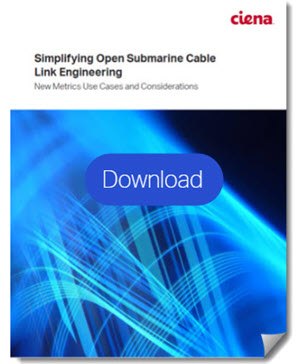Simplifying Open Submarine Cable Link Engineering
Submarine networks are different
Terrestrial networks leverage many optical line amplifiers and Reconfigurable Optical Add-Drop Multiplexer (ROADM) nodes to construct end-to-end networks. Fortunately, terrestrial amplifier and ROADM nodes are relatively simple to monitor to determine how each section contributes to end-to-end service performance, as each of these network elements provides a rich set of measured data.
Submarine cable systems are far more challenging because submerged repeaters (historical misnomer referring to optical amplifiers) and branching units provide only basic health status information. This design philosophy reduces the component count of undersea optoelectronics providing a higher overall reliability, which is a fundamental design goal of wet plants, because once deployed, they’re extremely expensive and time-consuming to repair. Given the limited information provided by most wet plants, end-to-end service performance must be determined from information provided by Submarine Line Terminal Equipment (SLTE) coherent optical modems connected at each end of a submarine cable.
The Open Submarine Cable business model
The industry is operating in a “quasi-open” submarine cable environment in that operators can and typically do select their wet plant from one vendor and their SLTE from another vendor, often much later, as wet plants take years to go from the designed to deployed stage. This quasi-open model allows operators to choose the latest and greatest SLTE, when and where needed, over the entire lifecycle of their wet plant allowing them to design and deploy a best-in-breed network tailored to their unique business requirements.
Facilitating the link engineering of Open Submarine Cables
 Recently, I discussed industry efforts to standardize the definition of cable specifications with our resident submarine networking expert, Priyanth Mehta. Priyanth explained how the industry is moving towards new metrics that can be used to simplify how submarine cable link budgeting is performed to address challenges associated with today’s open submarine cable model. Our discussion is the focus of our new “Simplifying Open Submarine Cable Link Engineering Handbook”.
Recently, I discussed industry efforts to standardize the definition of cable specifications with our resident submarine networking expert, Priyanth Mehta. Priyanth explained how the industry is moving towards new metrics that can be used to simplify how submarine cable link budgeting is performed to address challenges associated with today’s open submarine cable model. Our discussion is the focus of our new “Simplifying Open Submarine Cable Link Engineering Handbook”.
This free resource outlines a new and better way to perform open submarine cable link engineering with explanations on how this novel approach works, is measured, translates into capacity, impacts existing optical link budgeting, and aligns to the recently approved G.977.1 Recommendation from the International Telecommunications Union (ITU)
 “This new handbook describes the latest advancements in submarine network performance modelling and builds upon the foundation of available real-time capabilities provided by Ciena’s GeoMesh Extreme.”
“This new handbook describes the latest advancements in submarine network performance modelling and builds upon the foundation of available real-time capabilities provided by Ciena’s GeoMesh Extreme.”
– Priyanth Mehta, Ciena Submarine Networks Hardware Engineer
Open networks are the future – period
 “As wet plant performance specifications evolve, the associated metrics and parameters to accept and monitor cables must also evolve. This is exactly what this handbook helps operators to better understand.”
“As wet plant performance specifications evolve, the associated metrics and parameters to accept and monitor cables must also evolve. This is exactly what this handbook helps operators to better understand.”
– Darwin Evans, Submarine Networks Product Line Manager
As the openness juggernaut steamrolls across all parts of the global network, submarine networks will not be spared, nor should they be! Open networks provide numerous benefits to network operators, such as increased choice, faster innovation and pricing due to increased competition, broader and more secure supply chain, and many others. This new handbook helps operators to evolve from yesterday’s closed and proprietary submarine networks to tomorrow’s open and adaptive networks, overland and undersea.




